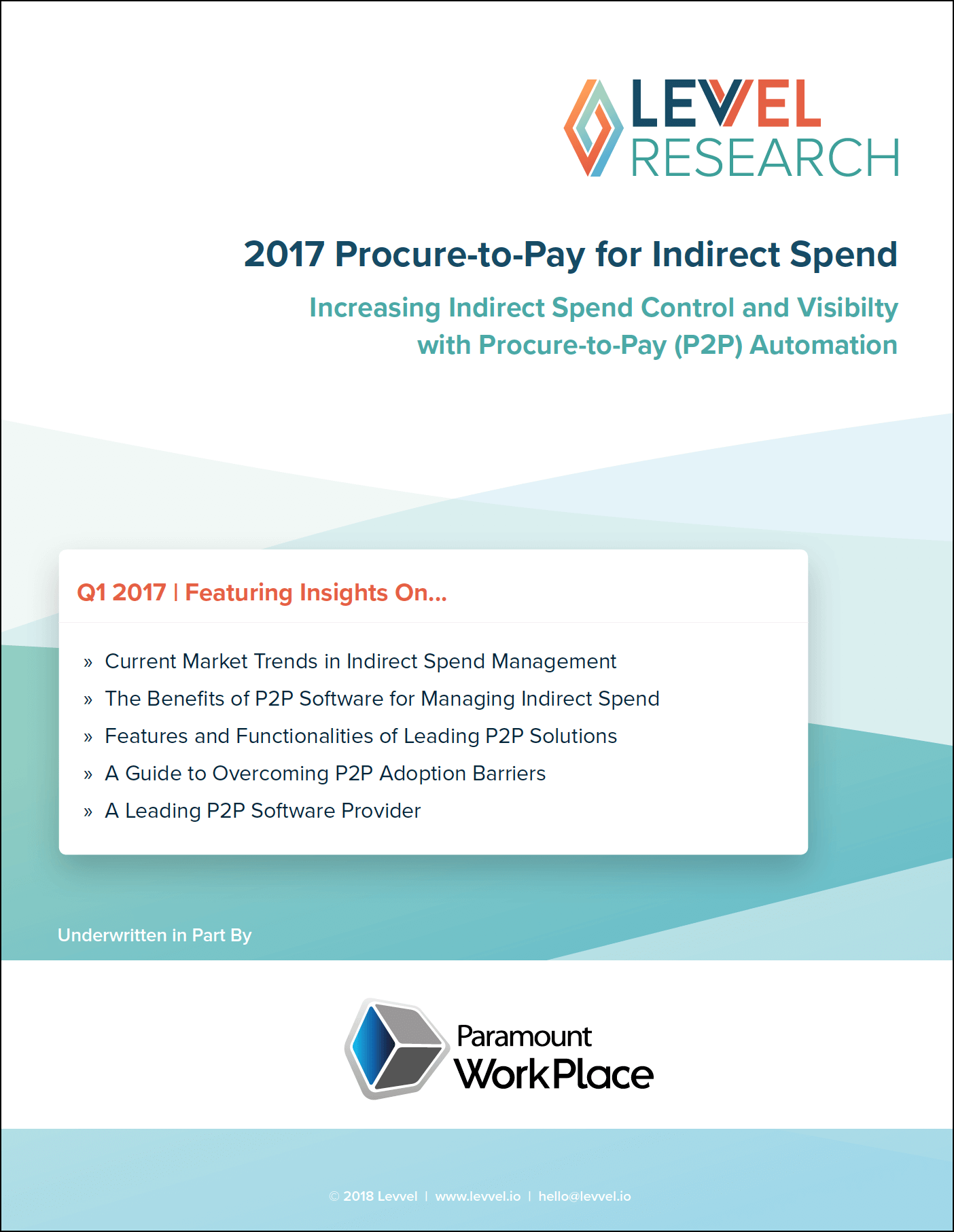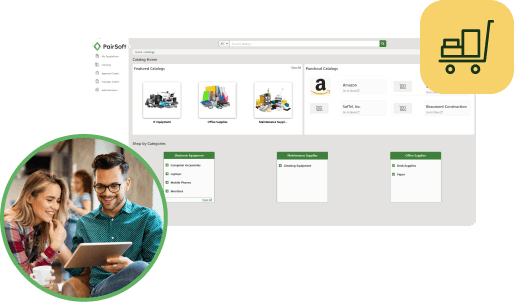
Janet Martin
Janet joined the PairSoft team upon its merger with Paramount Workplace, where she was also an integral part of the sales team for years. Janet resides in Michigan with her family.
View all posts by Janet MartinJanet Martin

Featuring insights on:
Organizations spend billions of dollars on indirect goods and services each year, and thousands of hours ensuring that those goods and services are ordered, delivered, and paid for efficiently. For some companies, managing indirect goods (also known as non-inventory goods or any good that doesn’t go into an organization’s final product) is handled by a large, centralized team of procurement and AP professionals. Others forego a centralized process and rely upon individual department heads to make sure all spend is properly accounted for. However the process is managed, one factor that can have a substantial effect on the success of a company’s Procure-to-Pay (P2P) lifecycle is its level of automation.
Manual P2P processes rely heavily upon email and phone-based requisitioning and order management, as well as paper-based invoice management and payment processing. Under a manual P2P process, organizations experience higher rates of process errors, limited visibility into the status of orders and payments, and very little insight into and control over indirect spend. Manual processes can lead organizations to spend millions each year in processing costs. On the other hand, when organizations leverage P2P software to automate processes, costs decrease and control increases. Procurement and AP departments gain visibility into how cash is moving and how employees and suppliers are interacting, and companies gain the ability to strategically manage cash flow.
Leading P2P software suites include solutions for electronic procurement (eProcurement), AP, and payments. These suites typically offer support for requisitioning, catalog management, order lifecycle management, receiving and reconciliation, invoice creation and approval workflow, supplier management, and electronic payments. The combination of these tools creates a more open and collaborative environment in back-office departments, and helps organizations accomplish some of their top P2P goals—increased visibility into and control over spend.
This report explores trends in indirect Procure-to-Pay among today’s organizations. It also highlights the features and benefits of advanced P2P automation tools, including eProcurement, eInvoicing, supplier management, and ePayments solutions.
“How would you best describe your current procurement process structure?”
In order to identify indirect P2P trends among North American organizations, Levvel surveyed over 250 back-office employees across several industries and market segments. This section focuses on some of the standard strategies organizations are using to manage indirect procurement, and how these processes are affected by a lack of automation.
Centralized procurement is typically the best-case scenario for effective procurement processing, as it lowers the chances of many process issues that can arise from disjointed ordering and poor companywide controls. Research shows that a majority of organizations have centralized procurement processes, see Figure 1. Understandably, size plays a role in this. Larger organizations are more likely to have decentralized processes than smaller organizations, as they typically have multiple locations. Smaller organizations are more likely to have no procurement department at all, as they will be the most likely to have too little spend or too small a budget to warrant a separate department.
While many organizations have a centralized procurement department, most are not using effective tools for ordering goods and communicating with suppliers. For example, among organizations that are not using eProcurement, the majority send POs via email to suppliers, see Figure 2. Others call suppliers directly, or perform an online search for the goods and services they need.
“How do you send the majority of your POs to supplier?”
These manual methods lack purchasing controls and auditing capabilities. They typically lead to over-budget employee spend and unregulated purchasing against stagnant supplier contracts with unchecked or out-of-date pricing. They also provide managers with little insight into market prices, the value of suppliers’ goods, or the success of past interactions with suppliers. In general, a manual process does not lend itself well to budgeting, project management, or inventory control; it requires managers to spend more time monitoring spend to maintain balance in those areas. Considering that some companies spend millions of dollars in indirect purchasing each year, inefficiently managing procurement spend can have a huge impact on a company’s profitability.
Levvel Research has also found that organizations are heavily reliant upon email and phone-based methods to handle the order management lifecycle. This means they often call or email a supplier directly when they need to check on or change an order. This can slow down or disrupt order fulfillment, sometimes causing processing costs to exceed expectations, damaging supplier relationships, and wasting procurement staff’s valuable time.
Levvel Research has found that manual procurement issues are reflected in organizations’ improvement goals. When asked where they would like to see improvement, survey respondents replied that they would like more control over costs and contracts, more visibility into spend, and improved interaction between back-office departments, see Figure 3.
“In what area would you like to see the greatest improvement to your procurement process?”
Organizations are also concerned with the smooth transfer of order information between the procurement and accounts payable department. When one or more department operates under a manual process, the P2P lifecycle is longer, more costly, and more prone to error.
One key way to accomplish these goals is to automate the procurement process with an electronic procurement solution. Research shows that organizations that have adopted these solutions have achieved the exact goals that those without the software aim for, see Figure 4.
“Which of the following improvements have you seen in your procurement process since implementing a solution? (Select up to three)”
Survey results show that over half of organizations have adopted an eProcurement solution—a 56 percent increase from 2016, see Figure 5. Levvel Research attributes this growth in adoption rates to increased awareness of the value of eProcurement technology for improving control, visibility, and profitability.
“Does your organization utilize an eProcurement solution?”
Similarly to procurement process structures, company size plays a role in whether an organization will adopt a solution. Adoption rates increase as company revenue increases, and smaller organizations are much less likely to adopt a tool, see Figure 6.
“Does your organization utilize an eProcurement solution?” & “What is your organization’s annual revenue in the most recent 12-month reporting period?”
Industry also has an impact on adoption, see Figure 7. Levvel attributes this to organizations’ industry-related indirect goods requirements. Healthcare and education have the highest rates of eProcurement adoption, as they are typically running widespread, decentralized procurement operations with high volumes of indirect good orders. On the other hand, manufacturing and retail companies are more likely to be connected directly to their supply chains, with a direct goods-focused tool. Organizations in the finance and banking industry also have high eProcurement adoption rates; Levvel has found that this industry is consistently more progressive when it comes to adopting back-office software.
“Does your organization utilize an eProcurement solution?” & “Please select the standard industry description that best fits your organization.”
With P2P software, purchasing and accounting professionals can handle all their procurement and order management tasks from one electronic platform. Employees in purchasing and other departments can fill out a purchase request for an indirect good or service, then send that requisition through a pre-configured approval workflow for review. These solutions also facilitate synchronization between purchasing and payment by automatically flipping POs to invoices after receipt, and enabling real-time communication between departments. P2P software allows organizations to handle millions of dollars’ worth of indirect spend in one intuitive system across multiple locations, department, and users.
The following section further highlights the features and services offered by P2P solutions tailored to indirect procurement.
A P2P software suite typically includes automation for the entire back-office lifecycle of requisitioning, purchasing, receiving, paying for, and accounting for indirect goods and services. A fully automated P2P process usually creates a harmonious relationship between procurement and accounting departments, enabling more transparency into and control over indirect spend.
Emerging in the 1990’s, early P2P solutions began as ERP-based, bolt-on purchasing and invoice management tools. They enabled organizations to see key process data more clearly, and integrated their disparate back-office processes. In recent years, the rise of cloud, or SaaS, technology has filled the market with more affordable and technically versatile options. These options are sold in holistic software suites or in modular forms, allowing organizations to automate processes as their growth and budgets allow. However, even if organizations automate gradually, full adoption of a P2P software suite should be the eventual goal, as it has long-lasting effects on profitability and competitive standing.
Procurement technology’s main features include requisition creation and workflow, in-house and punch-out catalogs featuring product information from thousands of suppliers, PO creation, and an order management interface that allows for full visibility into all order activity. These solutions often support PO flip to invoice and integration with AP as well.
An important element of eProcurement is the ability to route purchase requisition workflows to the appropriate team member, especially if it is common for an organization’s non-procurement staff to request indirect goods. In addition, Levvel Research has found that most companies have varied methods of sending purchase requisitions, whether to one designated procurement manager, managers in individual departments, or to different managers on different occasions. This means that a flexible requisition workflow tool—one that can be configured to operate across multiple departments, locations, and teams—is a must.
Another important aspect of eProcurement is order management—the tool valued most highly by organizations that have adopted eProcurement, see Figure 8. The order management module gives procurement departments real-time visibility into the status of orders at any point in the lifecycle. It also provides managers with control over shipping and receiving, and provides the ability to communicate with suppliers or internal stakeholders directly from within the solution. Order management is one of the most important tools for accomplishing organizations’ goals of increased visibility and control over spend.
AP automation involves paperless invoice processing through electronic invoicing and/or the scanning of paper invoices and data capture, invoice matching and exception management, approval workflow, and integration with electronic payments tools. Most P2P solutions integrate with AP software, facilitating seamless movement from requisition to payment. Many AP solutions also come with working capital tools, including Dynamic Discounting and Supply Chain Financing (SCF) offerings to improve DPO, increase revenue, and promote faster supplier payments.
Many solutions either offer in-house payment capabilities or directly integrate with leading payment solution providers. ePayments tools include ACH, wire, and commercial card payments. Commercial cards come in a variety of types, including corporate cards, traditional purchasing cards, ghost cards, and Virtual Account (VA) programs.
Most solutions offer some level of supplier management—either through self-service supplier platforms or simply via a searchable supplier directory. Other features include supplier data management, supplier risk assessment, and supplier analytics and reporting tools for insights and auditing.
Figure 8 shows that the supplier self-service portal is the second most valuable tool to organizations that have adopted eProcurement. Levvel Research attributes this to the improvements these portals can bring to supplier relationships. For example, 80 percent of organizations reported improved supplier relationships after adopting a supplier management tool.
Reporting and analytics tools allow purchasing, AP, and legal departments to pinpoint inefficient spend activity and identify areas for improvement. Features include out-of-the-box and/or ad-hoc reporting, interactive reporting dashboards with drill-down capabilities, integration with other analytics tools, and industry benchmarking for data analysis. Many P2P solutions also include audit trails and financial process support that automates accruals and postings.
P2P solutions facilitate complete, real-time visibility into all spend activity, and many offer components that promote consistent compliance with budgets for both general and project-based purchasing. An advanced P2P solution allows organizations to configure the solution to their unique business policies, and to designate different requirements, restrictions, and workflows for spend according to its characteristics (e.g., spend category, user, PO, or invoice amount). Many solutions also provide support for non-PO spend to ensure that these items are under the same level of control. This support can include special rules and workflows for non-PO invoices, as well as straight-through processing and automatic payment options for certain recurring invoices, such as utility bills.
“Which of these services, offered by an eProcurement supplier network, do you find most valuable? (Select up to three)”
Despite the obvious value and benefits of eProcurement technology, many organizations choose not to adopt a solution. This is due to many reasons—most commonly, the belief that current processes are working. Other adoption barriers can vary based on the company’s size, see Figure 9.
“What is the greatest barrier to procurement automation implementation in your organization?”
Procurement automation can be expensive, and budget restrictions are a reasonable concern when it comes to adopting a solution. However, not all organizations fully understand what a solution will cost. Levvel found that while companies in the lower-middle market ($30-100 million in revenue) tend to underestimate the cost of a solution, those with revenue between $501 million and $2 billion often overestimate the cost of eProcurement software implementation.
Any company that is hesitant to adopt a solution should try to gain a more accurate estimation of the software cost, then reevaluate adoption plans. As for smaller organizations, new solutions are emerging in the P2P market that are specifically designed for organizations with smaller budgets. These companies should make sure they are exploring the entire software market. In addition, they should also consider starting small—a company can begin with one procurement tool and plan to adopt more P2P solutions later on.
The failure to gain internal buy-in typically comes from two similar causes: a lack of education on the purpose and value of the solution, and the belief that the software will produce no ROI. However, any sound investment decision should involve extensive research and analysis. If organizations want to be sure of the value a solution will bring, they must look at their current processes, and evaluate their metrics. This includes processing times, labor costs, error rates, and the annual costs of existing systems, including maintenance. Once organizations have a clear picture of their current state, they will be much more successful at determining the potential results of automation adoption.
There are many tools available for companies wishing to estimate the ROI of software adoption, including Levvel’s recent Pitching ROI for AP report. Levvel Research suggests that practitioners wishing to persuade key decision makers in their organizations should take advantage of tools like these to build a stronger case for automation.
Related to the problem of gaining executive sponsorship, this issue can be one of the most persistent barriers to adoption—but it is one that is easily corrected. If organizations are not aware of the better options that are available, they will continue operating under inefficient processes. Levvel Research suggests they take the time to research the market and its offerings, as well as the effects of automation. Beyond accessing research material like this report, organizations should talk to their peers about their own process struggles and automation initiatives (if applicable), and contact vendors for a demonstration of a leading P2P solution.
Integrating a P2P solution with existing processes and systems can be challenging, especially for older and/or larger companies with multiple locations, or with legacy systems on which many back-office teams and processes are dependent. However, today’s P2P software providers take these issues into account. These providers offer cloud-based technology and advanced integration tools that make it easy to plug their solution into even the most complicated infrastructure. Many providers also have teams of integration specialists to help IT configuration during implementation, as well as business process consultants to help structure current operations around more efficient, technology-based processes.
If organizations apply the strategies listed above, they will be able to identify their needs, areas for improvement, and possible savings, and they will be empowered to move forward toward P2P adoption. In order to help these organizations in their adoption journey, the following profiles highlight the features offered by some of today’s leading P2P software providers.
PairSoft develops, sells, and supports advanced web-based and native mobile requisitioning, procurement, accounts payable, and expense solutions for mid-market organizations across a range of industries, worldwide. The user interface offers flexible Procure-To-Pay automation and robust expense reporting that is easy for employees, effective for management, and powerful for accounting.

Talk to an expert today to uncover how your team’s procurement stacks up against the top performers in your sector.



Many organizations start with manual receipt handling, fragmented card feeds and slow AP processes. Implement AI agents to auto-capture receipts, route approvals, enable punch-out buys and post to the ERP.
Result: faster batching, fewer errors and cost savings. “This saves us hours every month.”
Many organizations face slow, paper-heavy AP and fragmented procurement that waste time and inflate costs. AI Agents can automate approvals, PO matching and record sync to improve speed, accuracy and control. Client quote: “It freed up hours and made our process reliable.”
Operational drag and rising costs slow growth: teams waste time on manual tasks, misaligned priorities and opaque processes. AI Agents help automate routine work and coordinate actions across teams. “We’ve lost time to repeats and handoffs,” says a typical client.
Companies struggle with manual procurement, fragmented approvals, and costly integrations that slow growth and obscure spend. Our AI Agents streamline requisitions, POs, and invoice matching to cut manual work and improve visibility. “We were wasting time and missing insights,” says a client.

Many teams start with fragmented PO/AP systems, manual matching and delayed financial reporting. Deploying AI agents to automate PO checks, real-time encumbrance tracking and invoice matching reduces processing time and errors, delivering live budgets and faster closes. “Finally, we can see current balances and approve instantly.”
Many companies juggle growing invoice volumes and legacy systems. They struggle with manual processes, compliance gaps and limited headcount. Our AI Agents automate integrations, enforce rules and surface exceptions. The typical outcome: faster closes and measurable ROI. “We stopped chasing invoices.”